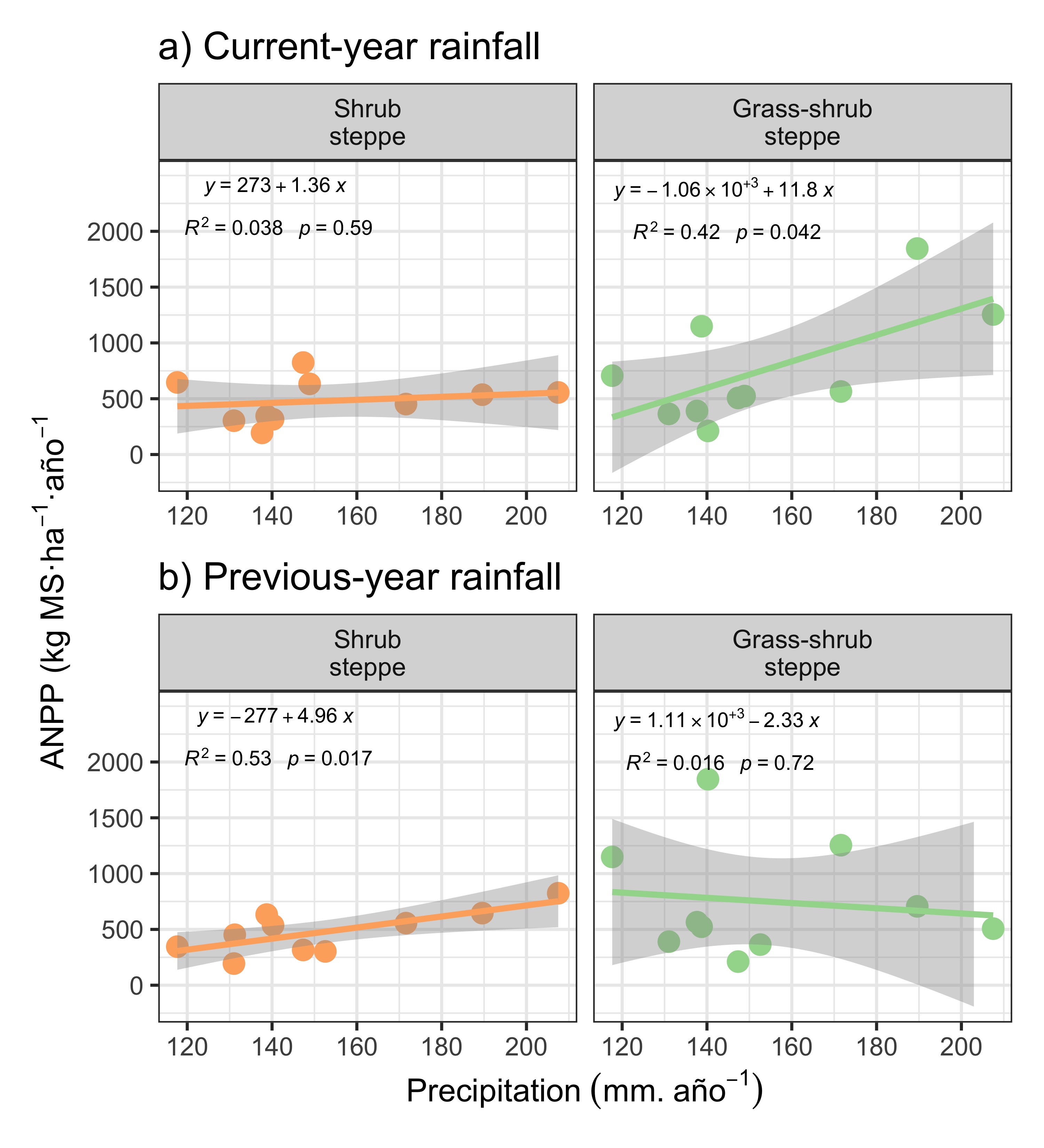Show code
library(tidyverse)
library(readxl)
library(patchwork)
library(ggview)
library(ggrepel)
library(gtsummary)
library(gt)
library(ggpmisc) # Para agregar la ecuación de la recta a cada faceta
library(broom)
library(sessioninfo)quarto, using tips and tools learned from courses, websites, and videos by Yan Holtz. I used a case study based on statistical data analysis from a research project on grazing ecology, led by Dr. Mariana Quiroga at INTA (National Institute of Agricultural Technology), Argentina. In this report I present the workflow I followed to produce different figures, tables, and inferential statistical analyses, which we later used for the manuscript submitted to the journal Ecología Austral (currently under review).

First, I load the libraries:
library(tidyverse)
library(readxl)
library(patchwork)
library(ggview)
library(ggrepel)
library(gtsummary)
library(gt)
library(ggpmisc) # Para agregar la ecuación de la recta a cada faceta
library(broom)
library(sessioninfo)And then I load the dataset, clean it, and make a few edits:
cobres_nueva <- read_excel("ANPP_Precipitaciones Oct Marz.xlsx", sheet = "Cobres_R") # esta es la nueva, con precipitaciones extrapoladas
cobres_nueva <- cobres_nueva %>%
mutate(
sitio2 = factor(sitio, labels = c("Shrub\nsteppe", "Grass-shrub\nsteppe"))
)The following analyses use rainfall estimated by Gaitán and Biancari (2024), method 2. On average, for each growing season (October to March), rainfall was 150.27 mm, with relatively low variability (CV = 18%), compared to the variability in ANPP.
cobres_nueva %>%
filter(sitio == "Campo") %>%
summarise(
media = round(mean(precip_gaitan_2, na.rm = T),2),
sd = round(sd(precip_gaitan_2, na.rm = T),2),
CV = round(sd/media*100,2),
min = round(min(precip_gaitan_2, na.rm = T),2),
max = round(max(precip_gaitan_2, na.rm = T),2)
) %>%
gt()| media | sd | CV | min | max |
|---|---|---|---|---|
| 150.27 | 26.98 | 17.95 | 117.66 | 207.49 |
Because this report targets a broad audience that may not be familiar with the Puna and its environments, it’s convenient to refer to the ecological sites in more general, structural terms. Cerro corresponds to a grass–shrub steppe on steep slopes, and Campo to a shrub steppe on flats. I used these shorter labels in the figures.
I summarize ANPP for both steppe types with a boxplot, also showing the arithmetic mean and the ANPP values for each year (gray points).
# Calculamos las medias de PPAN por sitio
# medias_ppna <- cobres_nueva %>%
# group_by(sitio) %>%
# summarise(media = mean(ppna, na.rm = TRUE))
# Graficamos
ggplot(cobres_nueva, aes(x = sitio2, y = ppna, fill = sitio)) +
geom_boxplot(
width = 0.4, outliers = F,
show.legend = F) +
geom_point(
size = 2,
width = 0.1,
height = 0,
alpha = 0.5,
position = position_jitter(width = 0.06, seed = 123),
show.legend = F) +
stat_summary(
geom = "point",
fun = "mean",
shape = 23,
size = 3,
fill = "white") +
# Colocamos el texto con geom_text_repel y curvamos la línea de conexión
# geom_text_repel(
# data = medias_ppna,
# aes(x = sitio, y = media, label = round(media, 1)),
# size = 2.5, color = "black", box.padding = 0.5, max.overlaps = 10,
# nudge_x = 0.5, nudge_y = 100,
# segment.linetype = "dashed"
# ) +
labs(
y = expression(paste("ANPP (kg MS·", ha^{-1}, "·", año^{-1})),
x = ""
) +
scale_fill_manual(values = c("#fdae6b", "#a1d99b")) +
scale_y_continuous(
limits = c(0, 2000),
breaks = seq(0, 2000, 500)
) +
theme_bw()
# ggview(width = 3, height = 3)
ggsave("Fig_cajas_medias.png", width = 3.5, height = 3.5, dpi = 600)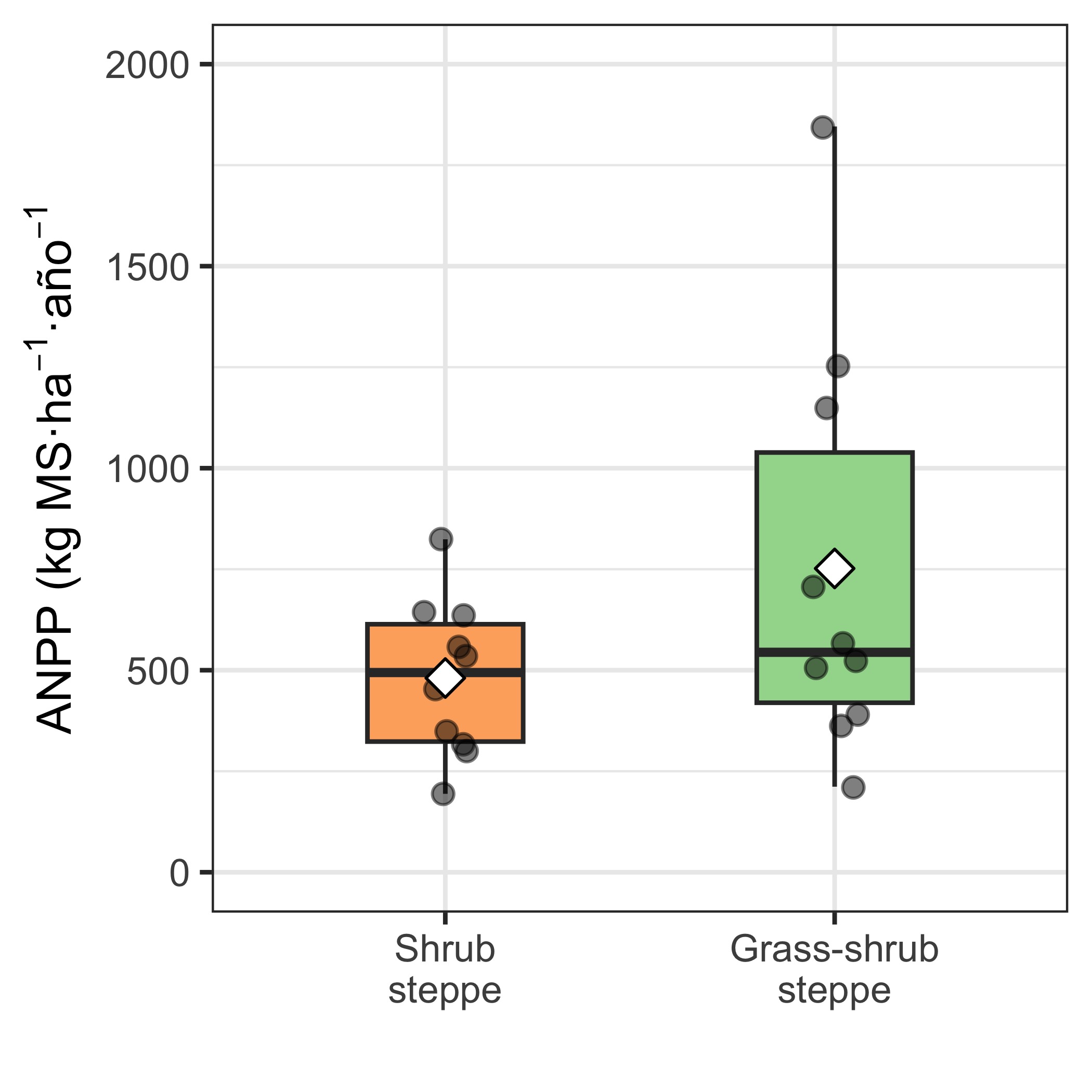
What we see in the sample cannot necessarily be generalized to the population. For that, we need Statistical Inference.
The average ANPP in the grass–shrub steppe (751.8 kg DM/ha/year) was 1.6 times higher than in the shrub steppe (480.7 kg DM/ha/year), and this difference was marginally significant (Table 2). ANPP variability in the grass–shrub steppe (CV = 67.7%; Range: 211.7–1845.7 kg DM/ha/year) was higher than in the shrub steppe (CV = 40.3%; Range: 194.1–824.1 kg DM/ha/year)(Figure 1)(Bartlett’s K-squared = 6.96, df = 1, p = 0.008).
# Realiza el análisis y extrae solo el valor t y el valor p
resultado_ttest <- cobres_nueva %>%
select(fecha2, sitio, ppna) %>%
pivot_wider(names_from = sitio, values_from = ppna, names_prefix = "ppna_") %>%
summarize(t_test = list(t.test(ppna_Campo, ppna_Cerro, paired = TRUE, alternative = "less"))) %>%
pull(t_test) %>%
purrr::map_df(~tibble(
estadistico_t = .x$statistic,
p_value = .x$p.value
))
# Crea la tabla elegante con gt
resultado_ttest %>%
gt() %>%
tab_header(
title = "Paired t-test"
) %>%
cols_label(
estadistico_t = "t",
p_value = "p-value"
) %>%
fmt_number(
columns = vars(estadistico_t, p_value),
decimals = 3
)| Paired t-test | |
|---|---|
| t | p-value |
| −1.698 | 0.062 |
The grass–shrub steppe tended to be more productive (difference marginally significant) and more variable than the shrub steppe.
Between the two visualizations (Figure 2 and Figure 3), Figure 3 is more informative, since it doesn’t make sense to facet Campo and Cerro into separate panels.
cobres_nueva %>%
ggplot(aes(x = fecha2)) +
facet_wrap(~sitio2) +
geom_col(aes(y = ppna, fill = sitio), show.legend = FALSE) +
geom_line(aes(y = precip_gaitan_2 * 9,
group = sitio,
color = "Precipitación"),
size = 0.5) +
scale_y_continuous(
name = expression(paste("ANPP (kg MS·", ha^{-1}, "·", año^{-1})),
limits = c(0, 2000),
sec.axis = sec_axis(~ . / 9, name = "Precipitation (mm)")) +
theme_bw() +
theme(axis.text.x = element_text(angle = 45, hjust = 1, size = 8)) +
labs(
# title = "Con precipitaciones en la estación de crecimiento (GEE)",
x = NULL,
y = expression(PPAN~"(Kg MS / año)")
) +
scale_fill_manual(values = c("#fdae6b", "#a1d99b")) +
scale_color_manual(values = "blue") +
theme(
axis.title.y.left = element_text(color = "black"),
axis.title.y.right = element_text(color = "black"),
legend.position = "bottom"
)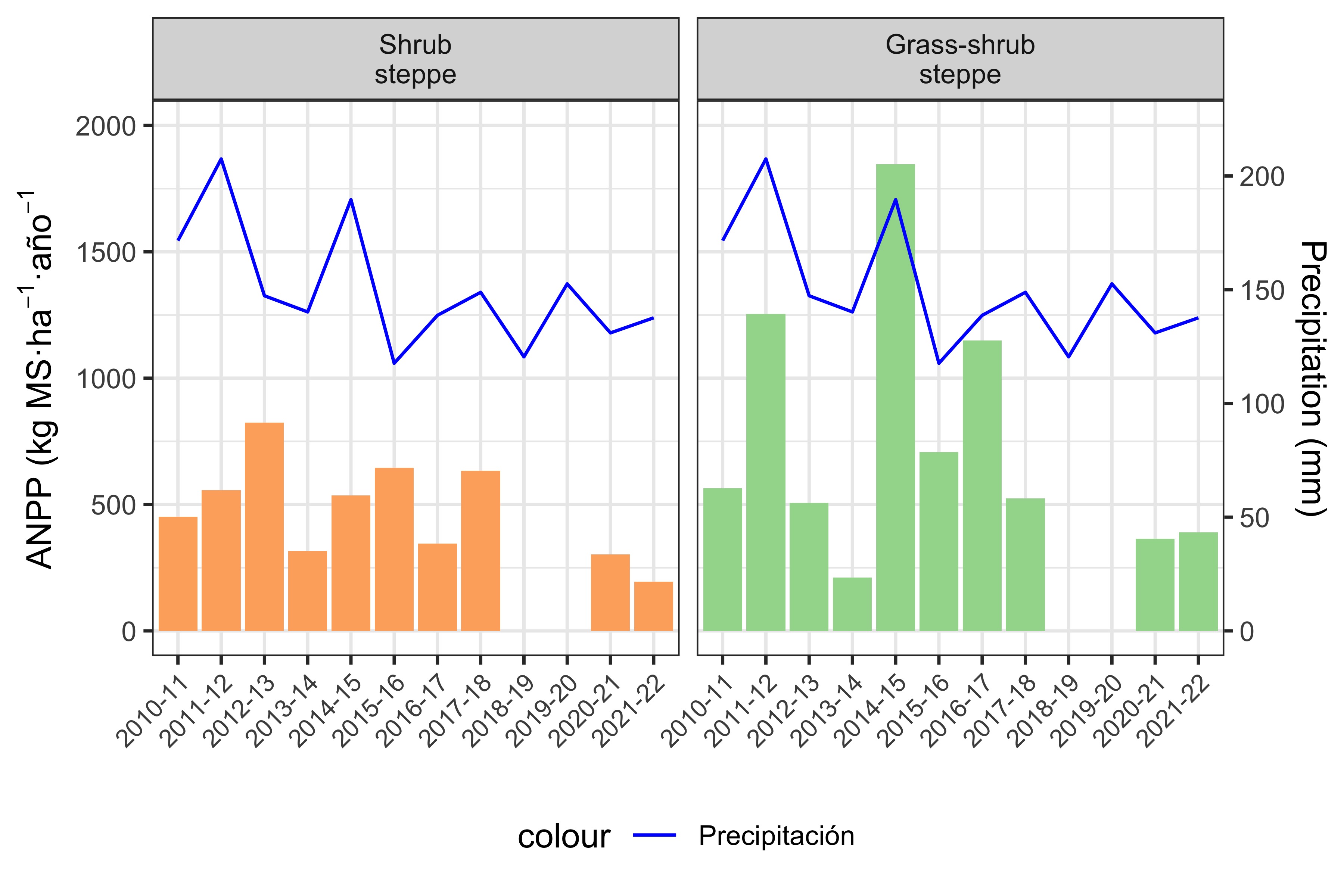
As Mariana mentioned in the WhatsApp group, ANPP’s response to rainfall differs by ecological site in the analyzed sample. In the grass–shrub steppe, ANPP closely follows rainfall in that growing season. In contrast, the shrub steppe’s response is delayed by one year: it depends on rainfall from the previous growing season (Figure 3).
cobres_nueva %>%
ggplot(aes(x = fecha2)) +
geom_line(aes(y = ppna, color = sitio2, group = sitio2),
size = 1,
na.rm = TRUE) + # PPAN como línea
geom_point(aes(y = ppna, color = sitio2, group = sitio2),
size = 1,
na.rm = TRUE) + # PPAN como línea
geom_line(
aes(
y = precip_gaitan_2 * 9,
group = sitio,
color = "Precipitación"
),
size = 0.5,
linetype = "dotted"
) + # Precipitaciones como línea
scale_y_continuous(
# name = expression(PPAN ~ "(Kg MS / año)"),
limits = c(0, 2000),
sec.axis = sec_axis(~ . / 9, name = "Precipitation (mm)")) +
theme_bw() +
theme(axis.text.x = element_text(
angle = 45,
hjust = 1,
size = 8
)) +
labs(x = NULL,
y = expression(paste("ANPP (kg MS·", ha^{-1}, "·", año^{-1})),
color = NULL,
# subtitle = "Precipitación de la estación de crecimiento (GEE)"
) +
scale_color_manual(values = c("#fdae6b", "#a1d99b", "blue")) + # Mismos colores que antes, agregando "blue" para Precipitación
theme(
axis.title.y.left = element_text(color = "black"),
axis.title.y.right = element_text(color = "black"),
legend.position = "bottom"
)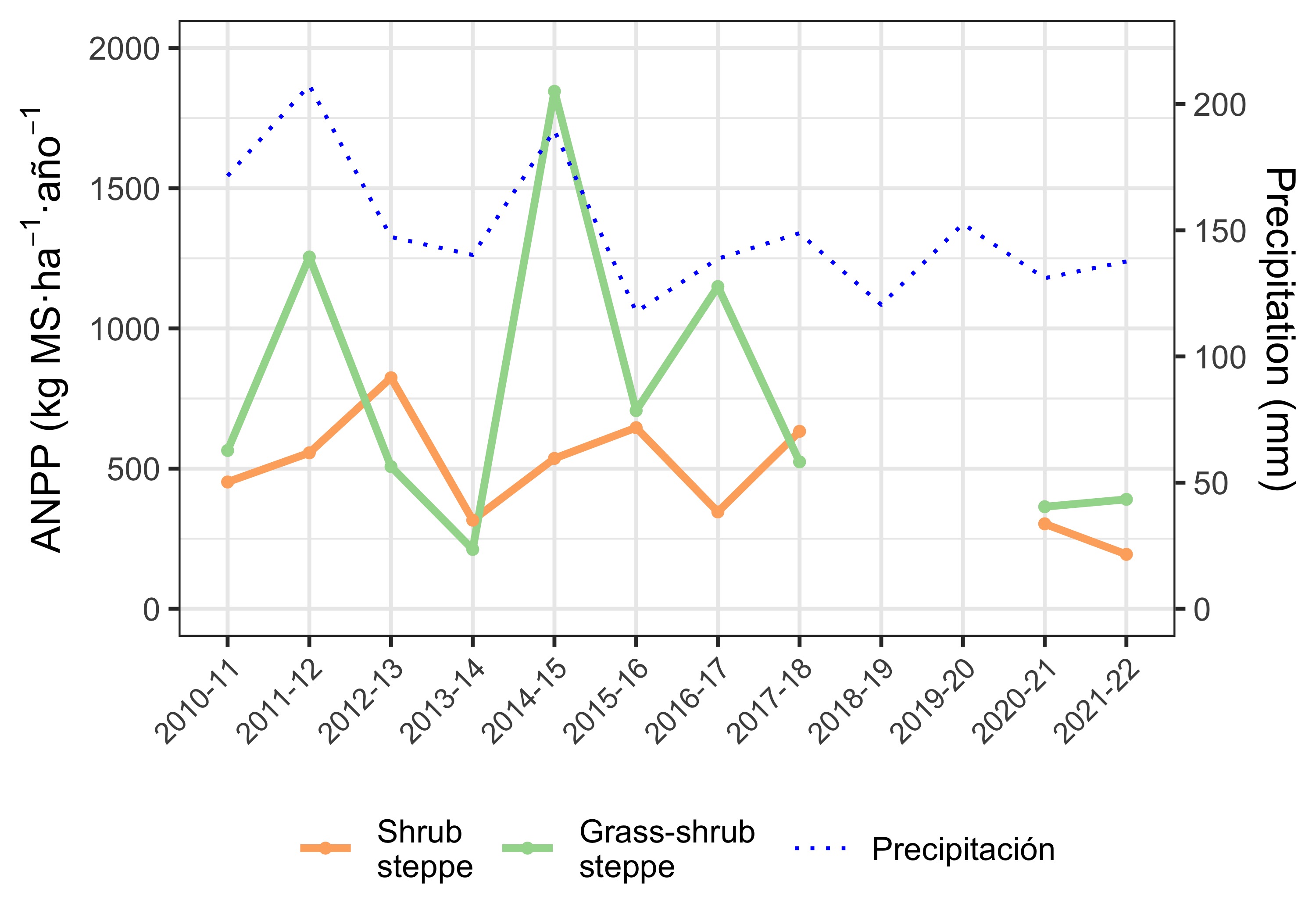
Eduardo suggested adding standard error bars on top of each bar (which represents the mean of the 3 exclosures). It’s a good suggestion; the updated plot can be seen in Figure 4.
cobres_nueva %>%
ggplot(aes(x = fecha2, y = ppna, fill = sitio2, group = sitio2)) +
geom_col(position = position_dodge(0.9), na.rm = TRUE) + # Barras de PPNA
geom_errorbar(aes(ymin = ppna, ymax = ppna + ppna_se),
width = 0.1,
position = position_dodge(0.9), na.rm = TRUE, color = "grey50") + # Barras de error alineadas
geom_line(
aes(
y = precip_gaitan_2 * 9,
group = sitio2,
color = "Precipitación"
),
size = 0.5,
linetype = "dotted"
) + # Precipitaciones como línea
scale_y_continuous(
# name = expression(PPAN ~ "(Kg MS / año)"),
limits = c(0, 2500),
sec.axis = sec_axis(~ . / 9, name = "Precipitation (mm)")
) +
theme_bw() +
theme(axis.text.x = element_text(
angle = 45,
hjust = 1,
size = 8
)) +
labs(x = NULL,
y = expression(paste("ANPP (kg MS·", ha^{-1}, "·", año^{-1})),
fill = NULL, color = NULL,
# subtitle = "Precipitación de la estación de crecimiento (GEE)"
) +
scale_fill_manual(values = c("#fdae6b", "#a1d99b")) +
scale_color_manual(values = "blue") +
theme(
axis.title.y.left = element_text(color = "black"),
axis.title.y.right = element_text(color = "black"),
legend.position = "bottom"
)
ggsave("Fig_barras_con_errores.png", width = 5, height = 3.5, dpi = 600)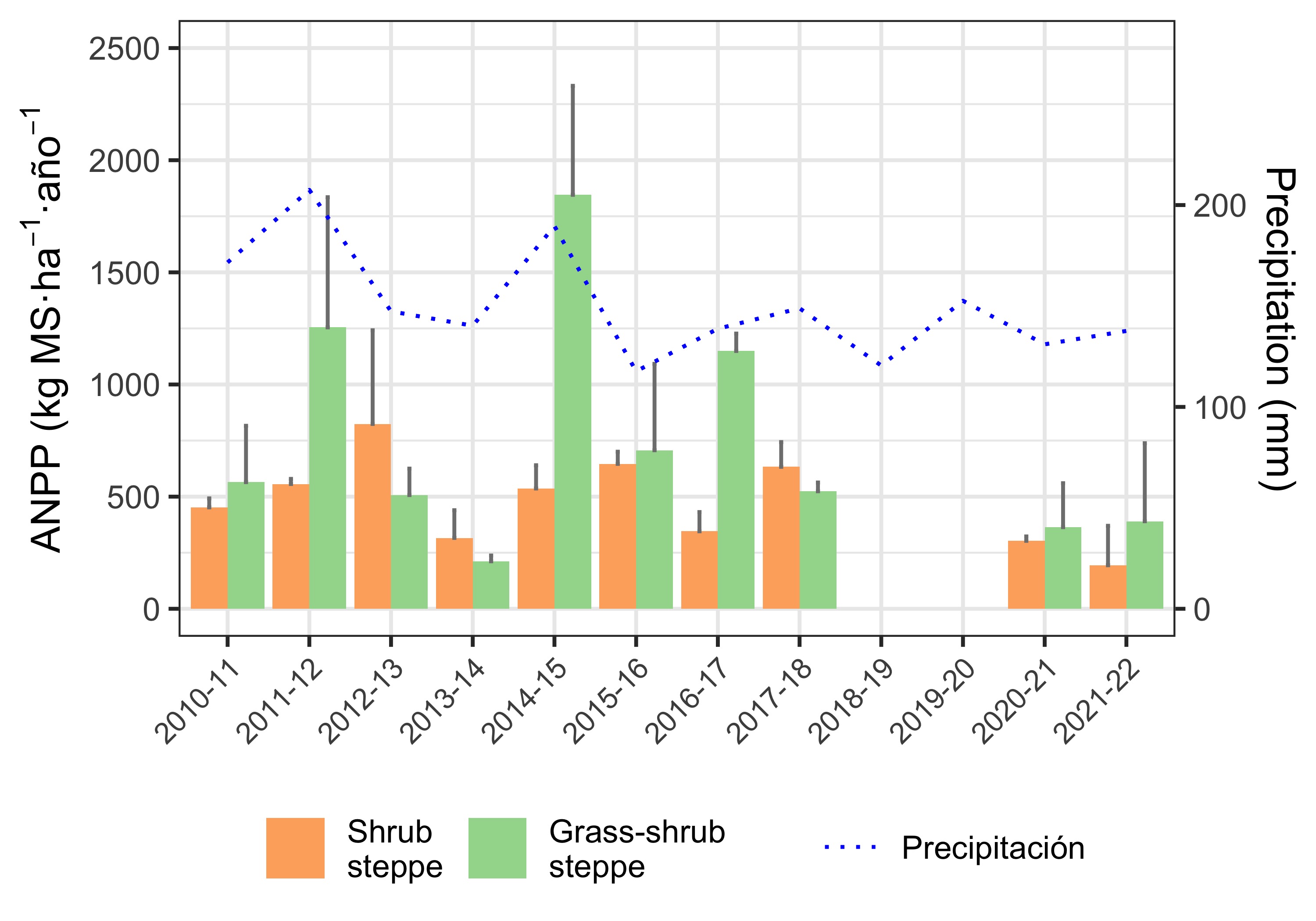
When analyzing the relationship between ANPP and rainfall during the harvest-year growing season, we find—as mentioned above—no relationship in the shrub steppe. In contrast, for the grass–shrub steppe there is a clear positive relationship in the analyzed sample. This indicates that ANPP depends linearly on rainfall during the same growing season in which ANPP was estimated (Figure 5).
cobres_nueva %>%
ggplot(aes(
x = precip_gaitan_2,
y = ppna)
) +
facet_wrap(~sitio2,
# scales = "free_y"
) +
geom_point(aes(color = sitio2),
size = 3,
show.legend = F) +
scale_y_continuous(
# limits = c(0, 2000)
) +
geom_smooth(aes(color = sitio2),
method = "lm",
# se = F,
show.legend = F) +
theme_bw() +
labs(
x = "Growing season rainfall in the harvest year",
y = expression(paste("ANPP (kg MS·", ha^{-1}, "·", año^{-1}))
) +
scale_color_manual(values = c("#fdae6b", "#a1d99b"))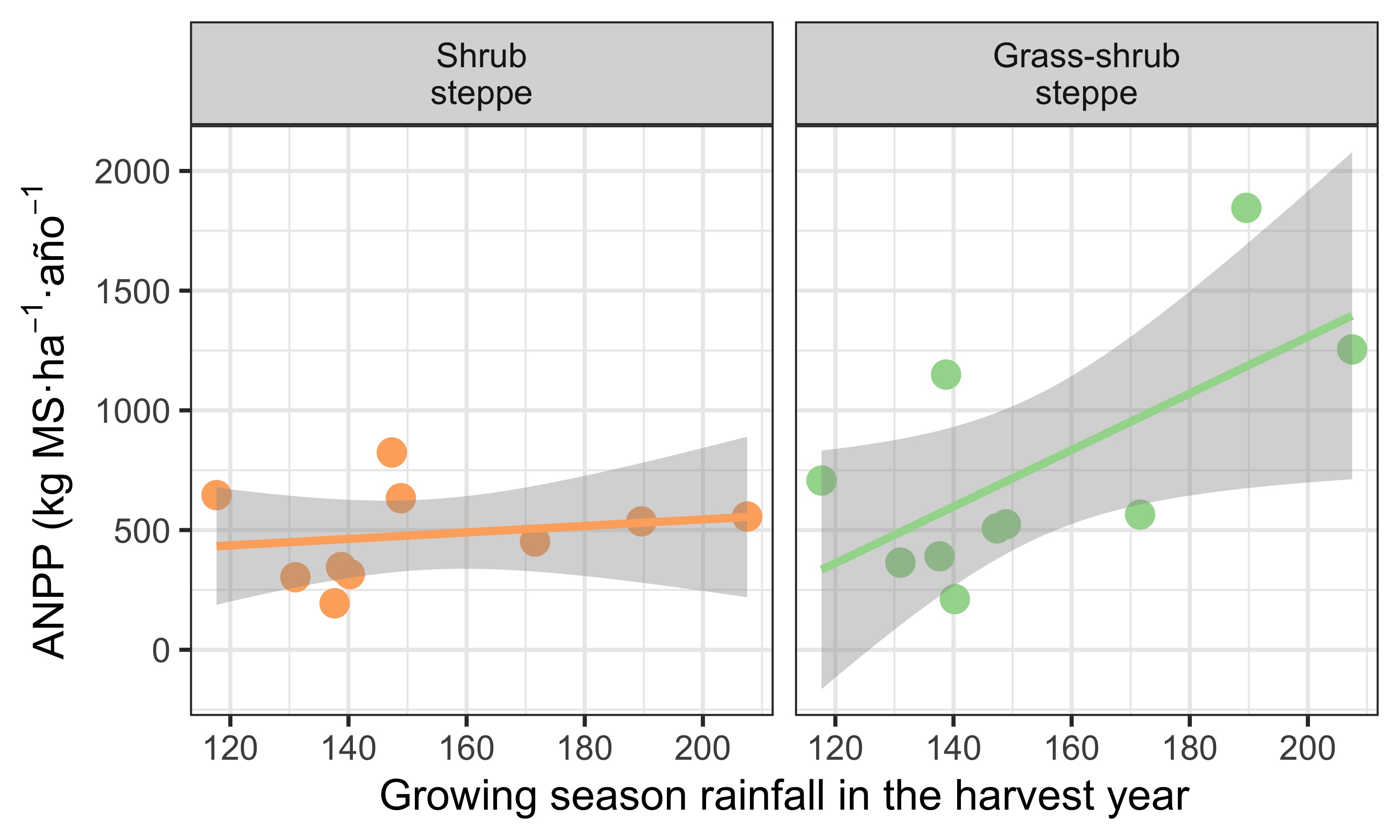
Exploring the relationship with rainfall from the previous growing season, the pattern reverses. In the shrub steppe, the relationship becomes positive: there is higher ANPP when it rained more in the previous growing season. In contrast, for the grass–shrub steppe there is no clear relationship (Figure 6).
cobres_nueva %>%
ggplot(aes(
x = precip_estacion_anterior_g2,
y = ppna)
) +
facet_wrap(~sitio2,
# scales = "free_y"
) +
geom_point(aes(color = sitio2),
size = 3,
show.legend = F) +
scale_y_continuous(
# limits = c(0, 2000)
) +
geom_smooth(aes(color = sitio2),
method = "lm",
# se = F,
show.legend = F) +
theme_bw() +
labs(
x = "Growing season rainfall in the previous year",
y = expression(paste("ANPP (kg MS·", ha^{-1}, "·", año^{-1}))
) +
scale_color_manual(values = c("#fdae6b", "#a1d99b"))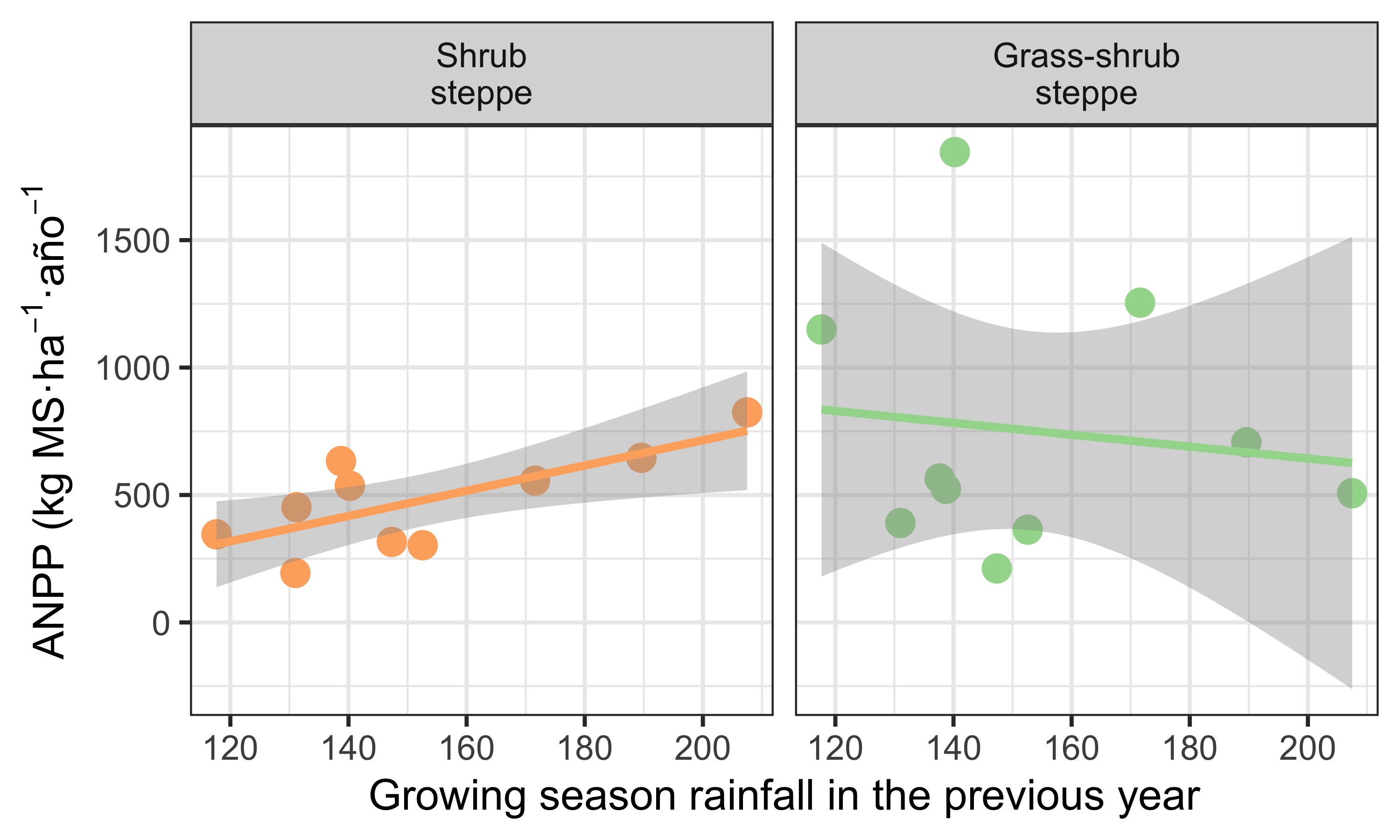
ANPP in the grass–shrub steppe responds to what it rained that same year, whereas ANPP in the shrub steppe responds to what it rained the previous year.
Up to this point, we’ve looked at relationships in this sample of exclosures and years. To determine whether these trends can be extrapolated to the population, we use statistical inference. That means testing whether the relationship is statistically significant; note that “significant” does not always mean “important.”
What we see in the sample cannot necessarily be generalized.
When testing the model for ANPP with rainfall during the harvest-year growing season, we see no significant linear regression in the shrub steppe (b = 1.4, P = 0.6) (Table 3). In contrast, in the grass–shrub steppe there is a statistically significant regression, meaning we can extrapolate to the population of sites in the grass–shrub steppe (b = 12; P = 0.042).
The slope—representing the effect of harvest-year growing season rainfall on ANPP—is positive. This means that for each mm of rain in the grass–shrub steppe, ANPP increases by 12 kg DM/ha/year (Table 3). This value is the point estimate of rainfall’s effect on ANPP, and the 95% confidence interval indicates the effect could be between 0.54 and 23 kg DM/ha/year. The model fit is moderate, with \(R^2\) = 42.2%.
# Ajustar modelos
model_campo <- lm(ppna ~ precip_gaitan_2, data = subset(cobres_nueva, sitio == "Campo"))
model_cerro <- lm(ppna ~ precip_gaitan_2, data = subset(cobres_nueva, sitio == "Cerro"))
# summary(model_campo)
# summary(model_cerro)
# Crear tablas de resumen con R² en notas al pie
tabla_campo <- tbl_regression(model_campo, label = list(precip_gaitan_2 ~ "Current-year rainfall")) %>%
modify_header(label ~ "**Predictor**")
tabla_cerro <- tbl_regression(model_cerro, label = list(precip_gaitan_2 ~ "Current-year rainfall")) %>%
modify_header(label ~ "**Predictor**")
# Combinar tablas
tabla_merged <- tbl_merge(
tbls = list(tabla_campo, tabla_cerro),
tab_spanner = c("Shrub steppe", "Grass-shrub steppe")
)
# Agregar R² como fila adicional
# Convertir tabla a objeto gt, si no lo es ya
tabla_gt <- as_gt(tabla_merged)
# Agregar el R² en el encabezado
tabla_gt %>%
tab_header(
title = "Linear models results",
subtitle = sprintf("R² shrub = %.3f | R² grass-shrub = %.3f",
summary(model_campo)$r.squared,
summary(model_cerro)$r.squared)
)| Linear models results | ||||||
|---|---|---|---|---|---|---|
| R² shrub = 0.038 | R² grass-shrub = 0.422 | ||||||
| Predictor |
Shrub steppe
|
Grass-shrub steppe
|
||||
| Beta | 95% CI | p-value | Beta | 95% CI | p-value | |
| Current-year rainfall | 1.4 | -4.2, 6.9 | 0.6 | 12 | 0.54, 23 | 0.042 |
| Abbreviation: CI = Confidence Interval | ||||||
When I fit the ANPP model with rainfall from the previous growing season, the results flip. For the shrub steppe, there is a significant regression (b = 5.0; P = 0.017) (Table 4), whereas for the grass–shrub steppe we cannot claim a significant regression (b = -2.3; P = 0.7).
In the shrub steppe, the effect of previous growing season rainfall on ANPP is positive. The slope interpretation is that for each mm of rain in the shrub steppe, ANPP increases by 5 kg DM/ha/year (Table 4). This is the point estimate of rainfall’s effect on ANPP in the shrub steppe, and the 95% confidence interval indicates the effect may be between 1.1 and 8.8 kg DM/ha/year. Similarly, the model fit is moderate, with \(R^2\) = 52.9%.
# Ajustar modelos de regresión
model_campo <- lm(ppna ~ precip_estacion_anterior_g2, data = subset(cobres_nueva, sitio == "Campo"))
model_cerro <- lm(ppna ~ precip_estacion_anterior_g2, data = subset(cobres_nueva, sitio == "Cerro"))
# Crear tablas de resumen para cada modelo y cambiar el nombre de precip
tabla_campo <- tbl_regression(model_campo, exponentiate = FALSE,
label = list(precip_estacion_anterior_g2 ~ "Previous-year rainfall")) %>%
modify_header(label ~ "**Predictor**")
tabla_cerro <- tbl_regression(model_cerro, exponentiate = FALSE,
label = list(precip_estacion_anterior_g2 ~ "Previous-year rainfall")) %>%
modify_header(label ~ "**Predictor**")
# Combinar tablas
tabla_merged <- tbl_merge(
tbls = list(tabla_campo, tabla_cerro),
tab_spanner = c("Srhub steppe", "Grass-shrub steppe")
)
# Agregar R² como fila adicional
# Convertir tabla a objeto gt, si no lo es ya
tabla_gt <- as_gt(tabla_merged)
# Agregar el R² en el encabezado
tabla_gt %>%
tab_header(
title = "Linear model results",
subtitle = sprintf("R² shrub = %.3f | R² grass-shrub = %.3f",
summary(model_campo)$r.squared,
summary(model_cerro)$r.squared)
)| Linear model results | ||||||
|---|---|---|---|---|---|---|
| R² shrub = 0.529 | R² grass-shrub = 0.016 | ||||||
| Predictor |
Srhub steppe
|
Grass-shrub steppe
|
||||
| Beta | 95% CI | p-value | Beta | 95% CI | p-value | |
| Previous-year rainfall | 5.0 | 1.1, 8.8 | 0.017 | -2.3 | -17, 12 | 0.7 |
| Abbreviation: CI = Confidence Interval | ||||||
In the grass–shrub steppe, ANPP responds to rainfall in the same year’s growing season. For each mm of annual rain, ANPP increases by 12 kg DM/ha/year.
In contrast, in the shrub steppe ANPP responds to rainfall in the previous year’s growing season. For each mm of annual rain, ANPP increases by 5 kg DM/ha/year.
fig_reg_1 <-
cobres_nueva %>%
ggplot(aes(x = precip_gaitan_2, y = ppna)) +
facet_wrap(~sitio2) +
geom_point(aes(color = sitio2), size = 3, show.legend = FALSE) +
geom_smooth(aes(color = sitio2), method = "lm", show.legend = FALSE) +
stat_poly_eq(
aes(label = after_stat(
paste(
"atop(",
..eq.label..,
",~italic(R)^2~`=`~", signif(..r.squared.., digits = 2), # Redondeamos R² a 2 decimales
"~~~", expression(italic(p)), "~`=`~", signif(..p.value.., 2), ")"
)
)),
formula = y ~ x,
parse = TRUE,
size = 2.5,
label.y = 0.95
) +
theme_bw() +
labs(
title = "a) Current-year rainfall",
x = NULL,
y = expression(paste("ANPP (kg MS·", ha^{-1}, "·", año^{-1}))
) +
scale_y_continuous(
limits = c(-200, 2500), breaks = seq(0, 2000, 500)) +
scale_color_manual(values = c("#fdae6b", "#a1d99b"))
fig_reg_2 <-
cobres_nueva %>%
ggplot(aes(
x = precip_estacion_anterior_g2,
y = ppna)
) +
facet_wrap(~sitio2,
# scales = "free_y"
) +
geom_point(aes(color = sitio2),
size = 3,
show.legend = F) +
scale_y_continuous(
# limits = c(0, 2000)
) +
geom_smooth(aes(color = sitio2),
method = "lm",
# se = F,
show.legend = F) +
stat_poly_eq(
aes(label = after_stat(
paste(
"atop(",
..eq.label..,
",~italic(R)^2~`=`~", signif(..r.squared.., digits = 2), # Redondeamos R² a 2 decimales
"~~~", expression(italic(p)), "~`=`~", signif(..p.value.., 2), ")"
)
)),
formula = y ~ x,
parse = TRUE,
size = 2.5,
label.y = 0.95
) +
theme_bw() +
labs(
title = "b) Previous-year rainfall",
x = expression("Precipitation" ~ (mm.~año^-1)),
y = expression(paste("ANPP (kg MS·", ha^{-1}, "·", año^{-1}))
) +
scale_y_continuous(
limits = c(-200, 2500), breaks = seq(0, 2000, 500)) +
scale_color_manual(values = c("#fdae6b", "#a1d99b"))
fig_reg_1 / fig_reg_2 +
plot_layout(guides = "collect", axis_titles = "collect")
ggsave("Fig_regresiones_juntas.png", width = 5, height = 5.5, dpi = 600)